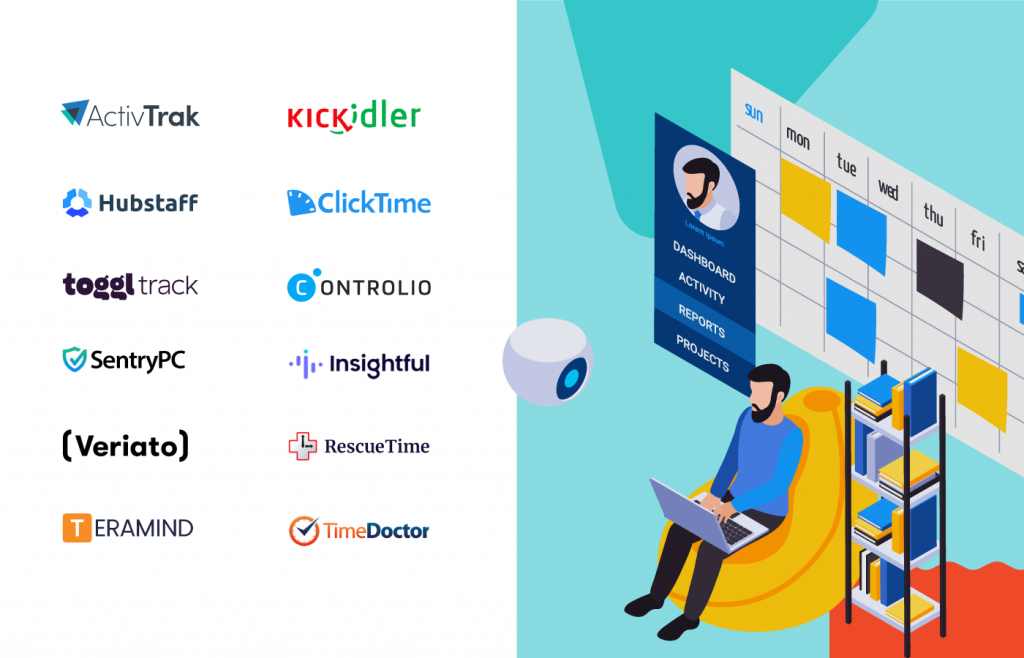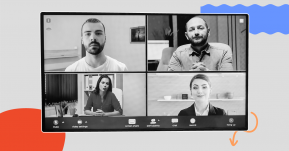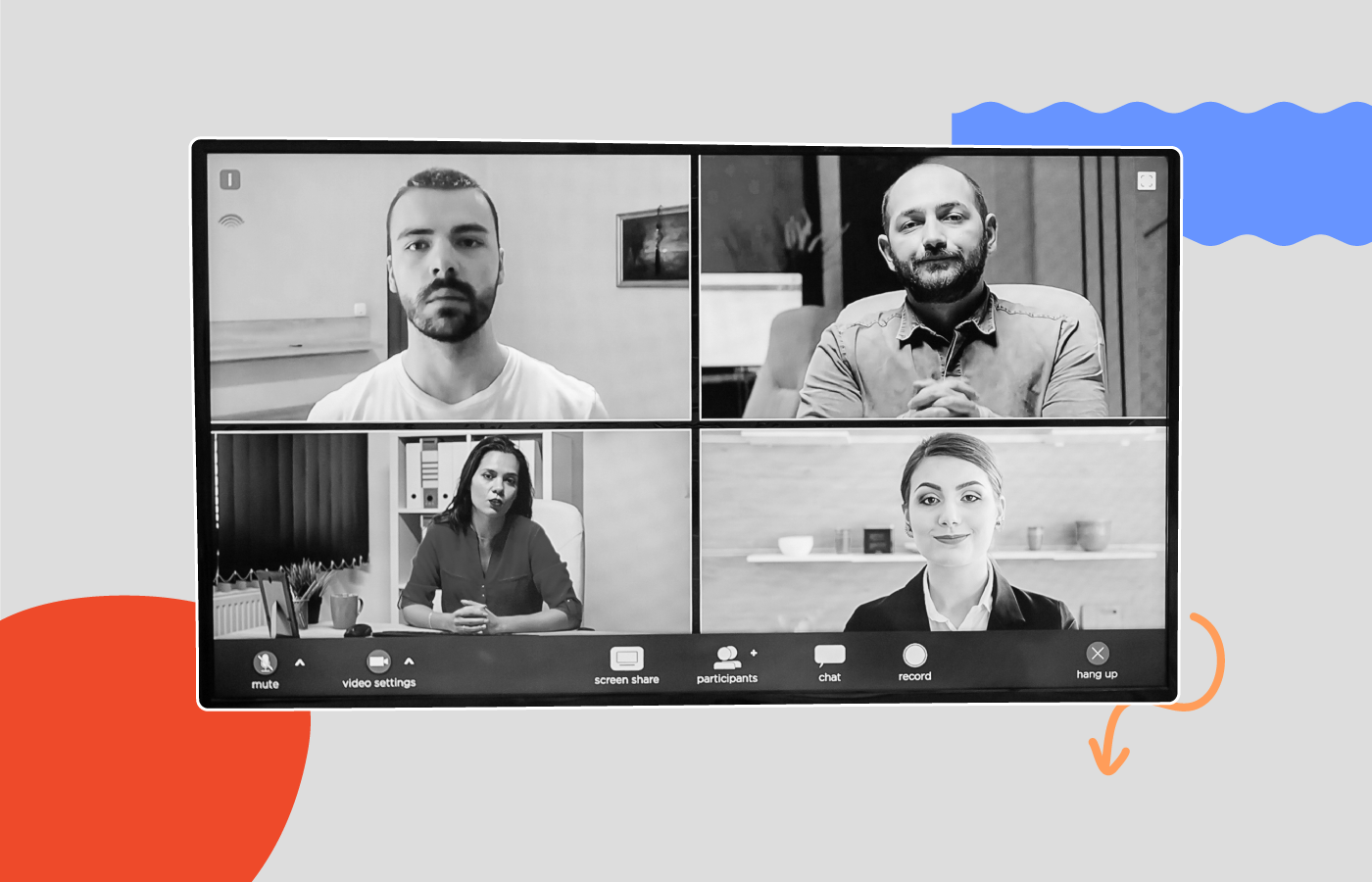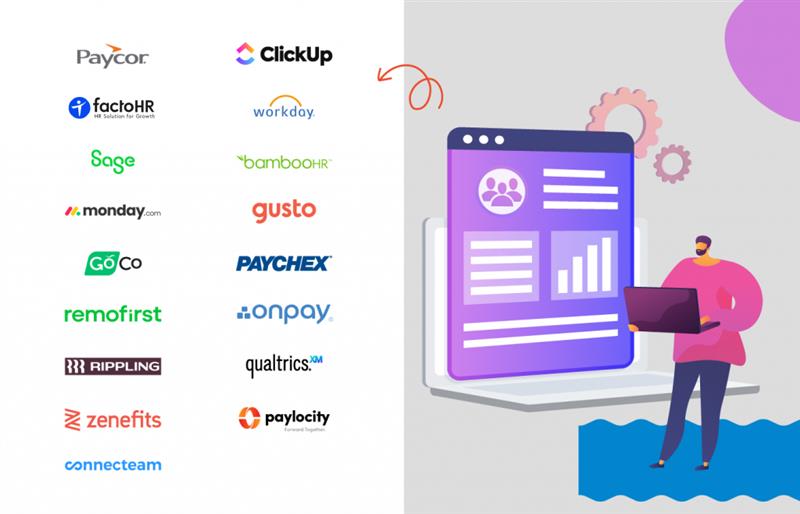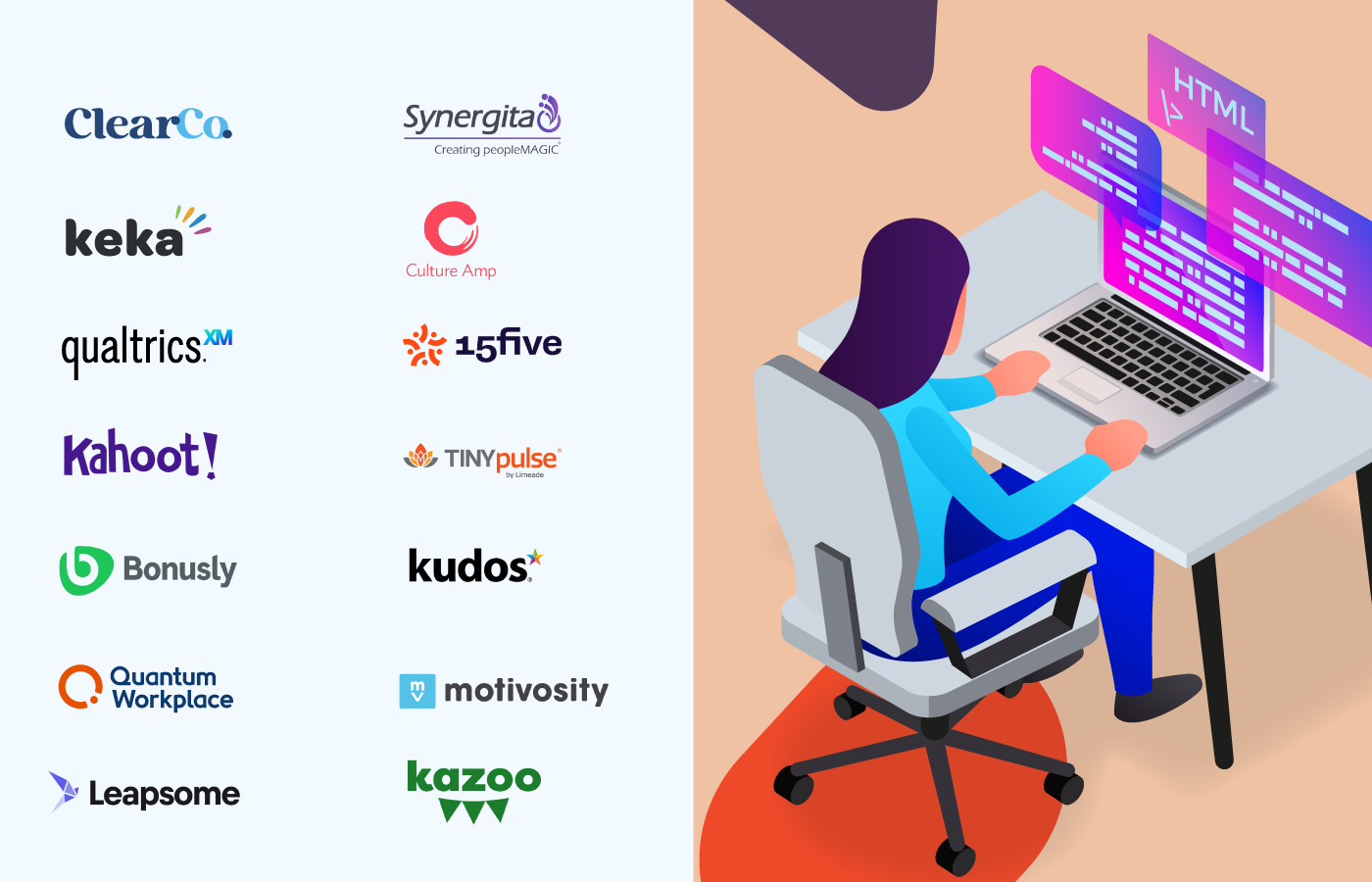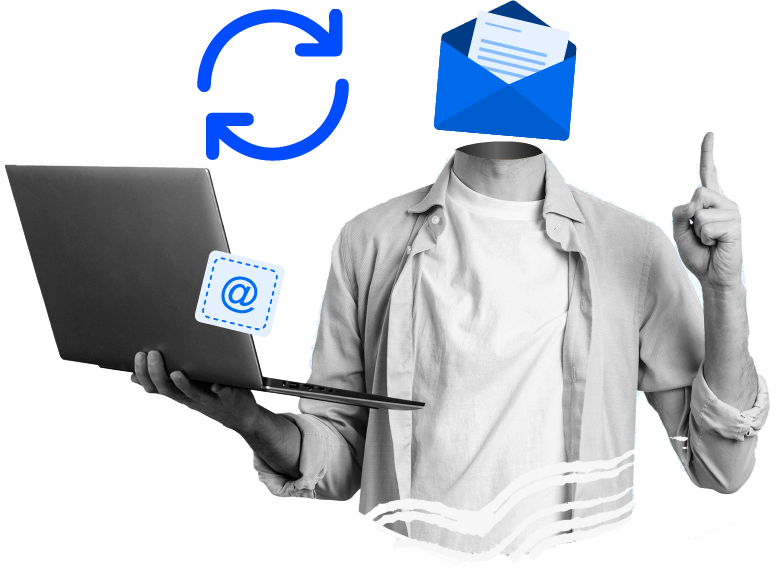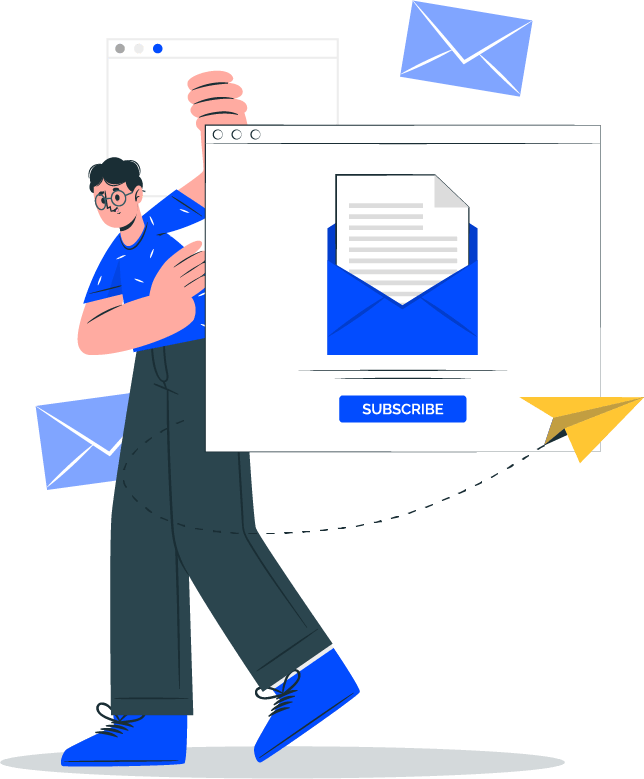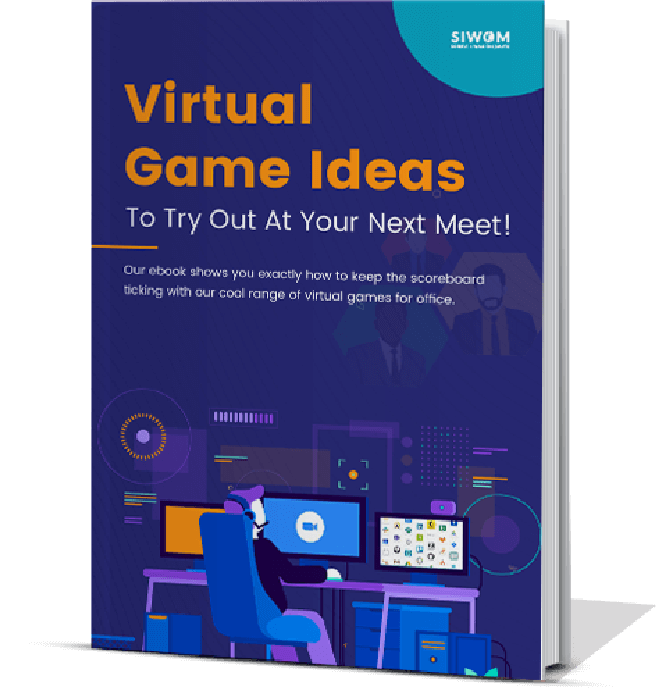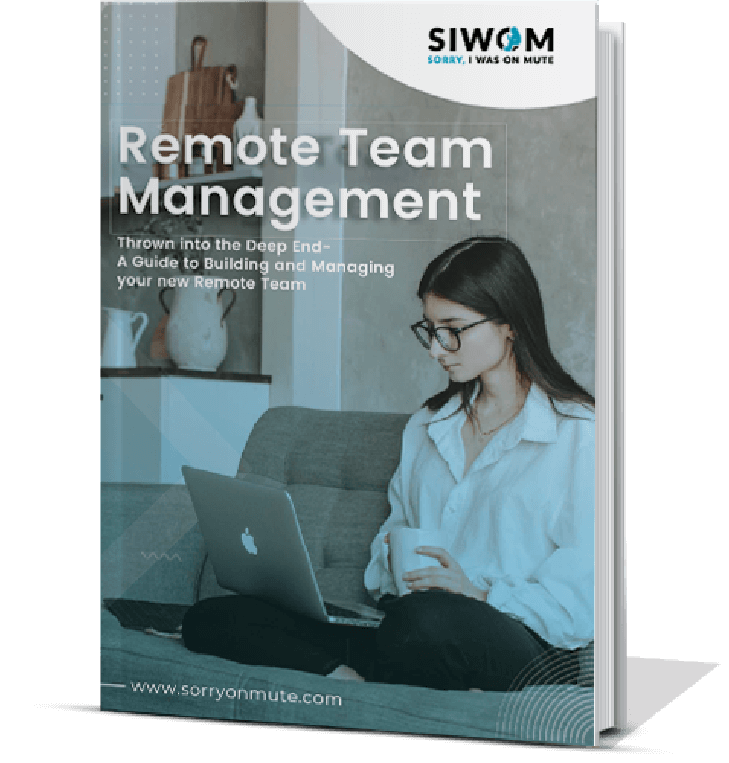3. Comparison Criteria Of Employee Monitoring Software
An employee tracking software’ should have features necessary to meet your monitoring and reporting needs. This includes activity monitoring, time tracking, screen recording, productivity analytics, remote access, privacy controls, integration with other tools, alerts and notifications, and data security.
Ease of use refers to whether the software is easy to install, configure, and use, with an intuitive interface that allows you to quickly access the features you need. The software should also be easy to integrate with other tools and systems.
The Employee Monitoring Software you pick should allow you to customize the monitoring settings to meet the specific needs of your organization and employees, including the ability to set different monitoring thresholds for different employees or departments.
The software should be scalable to accommodate the needs of your organization as it grows and evolves over time, with the ability to add or remove users, features, or modules as needed.
4. Key Features of An Employee Monitoring Software
The employee monitoring software should be able to monitor the employee's activity on their computer in real-time, or by generating daily, weekly, or monthly reports. This can include websites visited, applications used, keystrokes, mouse movements, file transfers, and more. Some employee monitoring software can even detect when an employee is away from their computer or has left their desk.
The remote employee software should provide you with the ability to track the amount of time an employee spends on different tasks, projects, and applications. This can help you identify where employees are spending too much or too little time and how you can better allocate resources. Time tracking features can also help you calculate payroll, billing, and project costs.
Detailed reports and analytics on the employee's productivity are essential features of employee monitoring software. This can include metrics such as time spent on different tasks, applications, and websites, as well as idle time, breaks, and distractions. Productivity analytics can help you identify bottlenecks in your workflow, improve resource allocation, and optimize your team's performance
where you need deeper insights on the data, most software may not have those functions built in. In which case, you can use Power BI. Enrolling yourself on something like this power bi course will be invaluable in learning how to play with the data and really understand where the business can improve efficiency."
Remote access allows you to access the employee's computer from anywhere with your employee tracking software, which can be useful for troubleshooting issues, providing support, or monitoring their activity when you are not physically present. However, remote access can also raise privacy and security concerns, and it is important to ensure that the employee's consent is obtained before enabling this feature.
5. Top 12 Remote Employee Monitoring Software

Time Doctor - Best Remote Employee Monitoring Software for Time Tracking
Ideal for small to medium-sized businesses. Clients include Thrive Market and Boost Media

Time Doctor was founded in 2012 by Rob Rawson and Liam Martin and is a remote employee software. Both of them developed Time Doctor’s features around the belief that the future of work is remote, enabling their customers to set up distributed teams. A few such customers include SEOZEO, Ericsson, and Verizon.
Time doctor
lets employers track virtual logins and logouts, client billable hours, and the sites their remote staff visit during work hours.
What makes Time Doctor unique?Core
Time Doctor features
are attendance,
project management
and budgeting, payroll, timesheets, website monitoring, and time tracking. But what we really like are the distraction alerts. It detects excess social media time and reminds the user to get back on track through pop-ups. This way, you’re getting a breather but are also reminded of when it's time to refocus, which is great!
Key Features:- Time tracking
- Project management
- Productivity monitoring
- Payroll management
PricingWhile the standard plan, priced at USD 10 per month, is the most popular package, there are basic and Premium plans for USD 7 and 20, respectively. If you’re looking for a tool with many integrations and more activity and time-tracking components, the standard plan sounds like the one you should consider.
Pros- Time Doctor is easy to use and intuitive, with a simple interface and user-friendly design.
- It offers a range of features beyond basic time tracking, such as project management, productivity monitoring, and payroll management.
- The software provides detailed insights into employee activity, allowing managers to identify areas where productivity can be improved.
- It offers integration with a wide range of other tools and platforms, such as Trello, Asana, and Slack.
Cons- The software can have glitches, especially when trying to track time accurately
- It is expensive software, and small businesses or those with a large number of employees might not find the pricing feasible
- The mobile app can be slow
ActivTrak - Best Remote Employee Monitoring Software for Activity Monitoring
Ideal for small to large-sized businesses. Clients include Mancosa, Hive360 and Nobu

ActivTrak has been in the market for eight years and was founded in Texas by Birch Grove Software. It is a user activity tracking application that picks up the most productive workflows to analyze employee engagement.
ActivTrak
is a productivity-tracking cloud-based app. It gives businesses visibility into user activity and lets employers configure and enforce remote work monitoring software policies.:
What Makes ActivTrak Unique?We liked that ActivTrak has use cases for insider threat detection features, data compliance and privacy, which aren’t commonplace in many
remote employee monitoring
tools. Also, the key insights are accessible on one dashboard and are bite-sized, making them easier to understand.
Key Features:- Employee monitoring
- Productivity analysis
- Real-time activity tracking
- Remote workforce management
Pricing:ActivTrak’s Freemium plan is free (and great!)for 3 users, while the advanced plan starts at USD 7 per user per month.
Pros- ActivTrak provides a comprehensive view of employee activity, allowing managers to monitor productivity, track time spent on tasks, and identify areas where improvements can be made.
- ActivTrak provides real-time activity tracking, allowing managers to respond quickly to any issues that arise.
- The platform is easy to use and user-friendly, with an intuitive interface that doesn't require extensive technical knowledge.
Cons- The platform does not offer advanced data visualization or analytics features, which may be limiting for some businesses.
- The software can slow down when tracking activity on certain applications or websites.
Hubstaff - Best Remote Employee Monitoring Software for Project Management
Ideal for small to medium-sized businesses. Clients include Kurve, Groupon, and Instacart.

Hubstaff is an
employee time tracking software
that was launched in 2012. Like Time Doctor, Hubstaff is powered by a 100% remote team. Other platforms in addition to time tracking, include
agile project management
and talent management for job finding and remote hiring..Hubstaff brings up shifts, time off requests, and team availability so that employers can plan and assign to-dos to remote teams.
What Makes Hubstaff Unique?The first thing we noticed about Hubstaff was how user-experience oriented its remote employee monitoring tools are. Our personal favorite was the
geofencing
feature that automatically starts and stops time tracking according to when members log in and log out. We also liked the option to add budget limits to new projects. It alerts you of clock-bound activities and lets you know how and where time is being spent.
Key Features:- Time tracking
- Project management
- Employee scheduling
- Payroll management
Pricing:If you intend to be the sole user, you can go for a
free plan.
The basic, premium, and enterprise plans are priced at USD 7, 10, and 20 and let you add more than 2 users.
Pros- Provides detailed time tracking and productivity monitoring, allowing managers to identify areas for improvement.
- Offers a range of features beyond basic time tracking, such as project management and payroll management.
- Can be customized to suit the specific needs of different businesses.
Cons- Some employees may find the monitoring intrusive or feel like they're being micromanaged.
- Some users have reported that the platform can be slow or buggy
- The screenshot feature can be seen as a potential invasion of privacy, particularly if employees are not informed of its use.
Kickidler - Best Remote Employee Monitoring Software for Improving Productivity
Ideal for all types of companies.

Kickidler has been one of the top employee monitoring software for almost a decade. This software helps to improve the productivity of employees, raise their discipline and impact the increase of business outcomes by around 15%. Business owners, CEOs, department heads or any decision maker can receive the user activity results for any period of time and make relevant decisions. Live monitoring is very easy to use and can be turned off at any time.
What makes Kickidler unique?Its most unique feature is the real-time monitoring which records every second and can be downloaded at any time. Kickidler also offers detailed reports on employee productivity based on the time used to work with websites and apps. Other user activity monitoring features include violation reports, URL reports, working time reports, and employee ratings. The latter is effective in boosting employee competition.
Key Features:- Detailed reports on employee productivity
- Real-time monitoring
- Violation reports
- URL reports
- Working time reports
- Employee rating
Pricing:Kickidler’s free plan is for 1 user, Kickidler Time Tracking and Kickidler Employee Monitoring (full control) is starting from 2.75$ and 5.5$, respectively.
Pros- Kickidler offers advanced visual monitoring tools, including real-time online monitoring of employees, video playback, and history.
- Kickidler suggests a wide range of employee productivity reports that can be considered one of the most sophisticated functionalities among its competitors. Moreover, it shows employee ratings according to their productive activity.
- By granting access to its functionalities for information security professionals, it prevents private information from being leaked or accessed by unauthorized personnel: sending automated reports, notifying the most hazardous websites and programs, and creating email notifications on certain activities defined by the employer.
Cons- Kickidler is still optimizing its mobile version of the following employees and soon will be available.
- The Cloud version of this monitoring system is currently available only for Time Tracking Version of the software but soon will also be available for Employee Monitoring (EM) variant.
Toggl - Best Employee Monitoring Software for Time Tracking and Project Management
Ideal for small to medium-sized businesses. Clients include PerceptionEngineering, Mediacurrent, and Mooveit.

Toggl is an Estonian-based time tracking app that has been in business since 2006. Like Hubstaff and TimeDoctor, Toggl transitioned to a
fully remote team
in 2014 and has registered over 1 million users since 2016. Toggl helps managers keep remote teams productive with its inbuilt idle-time detection and time-tracking facility. It breaks down hours by projects, tasks, and clients to help you ascertain which projects make you money, and which are holding teams back.
What Makes Toggl Unique?We liked the Toggl button that sends out tracking reminders. It also has time-sensitive idle detection that activates if you forget to stop the timer manually making it a great employee productivity monitoring software. You can then return and review time reports. We also like team members in a remote network who can assign billable rates to their work to ensure they’re paid fairly for the time they spend on tasks.
Key Features:- Time tracking
- Project management
- Time analysis
- Team management
Pricing:Compact time tracking comes with a
Starter plan
of USD 9. But if you’re a larger remote team, the USD 18 premium or enterprise custom pricing might be more your speed.
Pros- Provides simple and intuitive time tracking functionality.
- Offers integrations with a wide range of other tools and platforms.
- Can be used across multiple devices, including mobile devices.
Cons- Offers limited employee monitoring capabilities beyond basic time tracking.
- May not be suitable for larger organizations with complex payroll management needs.
- Some users may find the software too simplistic for their needs.
Teramind - Best Remote Employee Monitoring Software for Insider Threat Detection
Ideal for medium to large-sized businesses. Clients include companies like Globonics.

Launched in 2014,Teramind is based in the US and is a robust user behavior analytics tracking platform. It keeps track of expense and time entries. Teramind features Data Loss Protection(DLP) and User Activity Monitoring(UAM).However, the reports caught our attention with comparative metrics like active vs. idle time and productive and unproductive time.
What Makes Teramind Unique?We particularly liked Teramind policy and rules engine, which focuses on protecting businesses from data theft.
Teramind
is intended for businesses that want to monitor user actions when online. It maintains access logs across all devices to help track and control activity.
Key Features:- Employee monitoring
- User behavior analytics
- Productivity analysis
- Insider threat detection
Pricing:The minimum number of users is 5. There are both
on-premise and cloud-based plans,
which are priced at USD 25, USD 50, USD 60, and USD 90, respectively. The packs are Teramind Starter, UAM, DLP, and Teramind DLP (with content-based exfiltration rules)
Pros- Provides advanced employee monitoring and insider threat detection capabilities.
- Offers real-time activity tracking and alerts for potential security threats.
- Can be customized to suit the specific needs of different businesses.
Cons- Teramind can be expensive for smaller organizations or those with a limited budget.
- The software requires a certain level of technical expertise to set up and manage effectively.
SentryPC - Best Employee Monitoring Software for Remote Monitoring
Ideal for small to medium-sized businesses
 SentryPC
SentryPC
started as Access Control Software in 2001, which makes it one of the oldest monitoring tools in the space. The product offerings are for businesses, families, and schools.SentryPC monitors, filters, and controls user activities remotely. It lets managers specify hours for which attempts to access non-work-related sites should be blocked, thereby preventing virtual distractions.
What Makes SentryPC Unique?We like the real-time viewing and time management capabilities within SentryPC. It lets you view keystrokes, conversations, and even websites that are frequented. This can seem a tad too invasive, but this is because the product caters to schools and homes and is intended to secure your system against cybercrime targeting the vulnerable.
Key Features:- Employee monitoring
- Website filtering
- Application monitoring
- Time tracking
Pricing:SentryPC’s
pricing options
are divided according to the number of PCs supported. You can purchase a single system license for USD 59.95 or manage upto 50 (USD 995)and 100 PCs (USD 1595) with the
business 50
and
business 100
plans.
Pros- Provides a simple and cost-effective employee monitoring and website filtering solution.
- Provides a simple and cost-effective employee monitoring and website filtering solution.
Cons- SentryPC may not be suitable for businesses that value employee autonomy and trust.
- The software can be expensive, particularly for larger organizations.
Controlio - Best Remote Employee Monitoring Software for Real-Time Monitoring
Ideal for small to medium-sized businesses.
 Controlio
Controlio
is a remote monitoring tool launched in 2017 by EfficientLabs. Unlike Work examiner which is an on-premise solution, Controlio is web-based. It operates in the background under stealth mode and is free for up to 3 computers. Signing up for the Controlio dashboard is hassle-free. After you install the client program, you’ll get to monitor screens live, and record user activities. Since it's hosted on the cloud, there’s no limit to screenshots and time-stamped video recordings that can be uploaded.
What Makes Controlio Unique?We liked the fact that the tool is intuitive and easy to use. We aren’t big proponents of blocking certain websites for employees to use but if you are a company that deals with sensitive information, this is the tool for you. This platform also helps avoid micromanaging since the reports allow you to see all the statistics that truly matter. If you are looking for a work from home monitoring software, this is the perfect fit.
Key Features:- Employee monitoring
- Screen recording
- Keylogging
- Activity tracking
Pricing:USD 7.99 for Cloud, which lasts for 6 months. Ideal for small and medium-sized businesses. The
prices
for on-premise and AWS are custom.
Pros- Users and departments can receive productivity scores.
- The software captures video snapshots from multiple displays.
- Keylogging is synced with video recordings.
Cons- The video capture feature does not have AI or OCR functionality.
- Universal search functionality is not available.
ClickTime - Best Remote Employee Monitoring Software for Time and Expense Tracking
Ideal for small to medium-sized businesses. Clients include Vodafone,BlackRock, and American Express.
 ClickTime
ClickTime
is the oldest find in this post, going back all the way to 1997. A division of Mann consulting, Clicktime was initially a web-based timesheet that gradually expanded its capabilities to include reporting, expense and time-tracking, and employee hour and performance tracking.
What Makes ClickTime Unique?Three things we liked about ClickTime are their multi-device time-tracking, workforce planning and in-depth productivity report filtering based on employee, team or project. Also, there are templates for you to start on, such as resource planning,project cost estimation and capacity utilization, which we have not come across in the other remote employee tracking software discussed so far.
Key Features:- Time tracking
- Resource planning
- Project management
- Expense tracking
Pricing:The names and
pricing packages
are Starter (USD 9), team (USD 12), premier(USD 24) and enterprise (custom).
Pros- Provides comprehensive time tracking and resource planning capabilities.
- Offers integrations with a range of other tools and platforms.
Cons- Users may find the software too complex for their needs.
- Fairly expensive software in comparison to others
Veriato - Best Remote Employee Monitoring Software for Data Loss Prevention
Ideal for large businesses.

Veriato started out in 1998 and was one of the earliest-known entrants into internet monitoring. The different products are cerebral, investigator,vision, and ransom safe
Veriato’s
work-from-home friendly platform lets
remote managers
create daily activity logs and weekly vision reports (like a vision board). It gives visibility into what a remote resource is working on at any given time. Veriato is robust and protects your data from threats
What Makes Veriato Unique?We liked the
Vision platform,
in particular. It monitors employee productivity and records online activities,keystrokes typed, messages,online searches, website footfall,social media sites, and even the usage of USB sticks. This software works great irrespective of what your set up is, hybrid or remote.
Key Features:- Employee monitoring
- Insider threat detection
- User behavior analytics
- Web filtering
Pricing:Veriato is priced by the type of device (PC or Mac) and costs $150.00 per License for 3 - 9, $135.00 for 10 - 19 Licenses and $121.50 per License for 20 - 49 Licenses.
Pros- Veriato provides AI and psycholinguistic analysis.
- Business owners have complete control over the system's functions.
Cons- The lower-tier plans do not include the most useful features.
- The software requires a certain level of technical expertise to use.
RescueTime - Best Remote Employee Monitoring Software for Distraction Management
Ideal for small to medium-sized businesses. Clients includeWired, the Guardian, and Lifehacker.

Developed in 2008,
Rescuetime
has been in business as a remote work tracking software for 12 years and automates time tracking.
Rescuetime
is a time management platform for remote teams that lets them stay focused on their priorities while on the clock.
What Makes RescueTime Unique?We have mentioned RescueTime in a
previous read
but felt that it deserves to go into this compilation as well. We like how you can get a 360 degree picture on work meetings, calls, projects, and everything else to know where you need to scale back or hit the pause button on busywork.
Key Features:- Time tracking
- Productivity analysis
- Employee Self Service Management
- Goal setting
Pricing:$72 after the standard 14-day free trial.
Pros- Provides time tracking and productivity monitoring capabilities, allowing employees to optimize their workday.
- It provides a productivity pulse feature that can be used for self-gamification.
Cons- Some users may find the interface difficult to understand,
- While the free version may not offer enough functionality, the paid version can be expensive.
Insightful - Best Remote Employee Monitoring Software for Small and Mid-Sized Businesses
Ideal for small to medium-sized businesses. Clients include Noon Dalton, Loge, and Armut.

Insightful was founded in 2015 by Serbian entrepreneur Ivan Petrovic. It has been reported to have helped businesses save $10 million in time annually and boost clock-in time by 15%. Insightful is a productivity monitoring tool that analyzes web interactions, and labels work as productive or not for employers.
What Makes Workpuls Unique?We like that Insightful lets you categorize websites by their relevance to your work. This way, you know where to spend your time on. Also, it records attendance by breaking up the day into logins, break-times, and work hours.
Key Features:- Time tracking
- Employee monitoring
- Productivity analysis
- Project management
Pricing:Employee Monitoring
starts at USD 4.80, time tracking USD 6.40, and automatic time mapping USD 12. For bigger and better capabilities, go for a custom-quoted Enterprise plan.
Pros- Workpuls offers a range of monitoring features, including web and app activity tracking, keystroke logging, and screenshot capture.
- Workpuls offers a user-friendly interface that is easy to navigate and requires little training.
- The software includes productivity tracking and reporting, allowing managers to identify areas where employees may need additional support or training.
Cons- Workpuls can be expensive, particularly for larger organizations or those with a high number of employees.
- The risk of data mishandling or misuse could lead to legal or ethical issues.
6. Benefits of remote team tracking software
The most noticeable improvement of using a remote team tracking software is in the time you save. Rather than waste it speculating on what remote and distributed workers are up to, especially if you have just transitioned to a WFH model, you can instantly analyze productivity metrics and understand how everyone is getting on with their work.It reconciles information on timesheets as well as the cost and time of work, thereby minimizing the possibility of getting a wrong account of the work completed so far.After all, at the end of the day, managers are answerable to upper management, and businesses, in turn, are answerable to their clients. If time and effort go into unproductive pursuits, the end results are delays and inflated costs. And no client is going to be happy about that!So long as you are upfront and level with your teams as to what is being tracked and logged, there are many benefits to using remote team tracking software, which include;
- Accountability:
team members take ownership of the work they’re assigned and are motivated to maintain their productivity levels.
- Billing worth
you can retrieve time reports for proof of the hours spent on billable work, busywork and administrative tasks.
- Virtual organizational setup:
you can track work no matter where everyone is, eradicating the need for a physical workspace, and its associated running costs.
- Prioritizing work:
Decisions on scheduling and allocating work are backed by powerful data- such as work that is more time and labour-intensive.
- Time management and attendance:
employees can manage their time better and avoid having to stay late or log in early to remain on top of their workload.
 Remote employee monitoring is a set of activities that an employer takes to ensure that productivity and
performance are optimal
in a work-from-anywhere arrangement. It helps to improve transparency by giving context to interactions.According to Buffer's 2020
State of Remote Work
report, 80% of remote employees work from home, which means increased distractions that risk going unchecked. This naturally affects motivation no matter how self-disciplined you are. The objective of monitoring remote employees is to prevent mismanagement of work time while helping workers balance accountability and breaks. When employees are informed of how they are being tracked, they are more likely to remain self-aware of priorities and would not need constant reminding. More importantly, work is easier to track and reconcile against what is fed back to you verbally. With the right remote work monitoring software, you can detect idle time and enhance billable work based on productivity hours.
Remote employee monitoring is a set of activities that an employer takes to ensure that productivity and
performance are optimal
in a work-from-anywhere arrangement. It helps to improve transparency by giving context to interactions.According to Buffer's 2020
State of Remote Work
report, 80% of remote employees work from home, which means increased distractions that risk going unchecked. This naturally affects motivation no matter how self-disciplined you are. The objective of monitoring remote employees is to prevent mismanagement of work time while helping workers balance accountability and breaks. When employees are informed of how they are being tracked, they are more likely to remain self-aware of priorities and would not need constant reminding. More importantly, work is easier to track and reconcile against what is fed back to you verbally. With the right remote work monitoring software, you can detect idle time and enhance billable work based on productivity hours.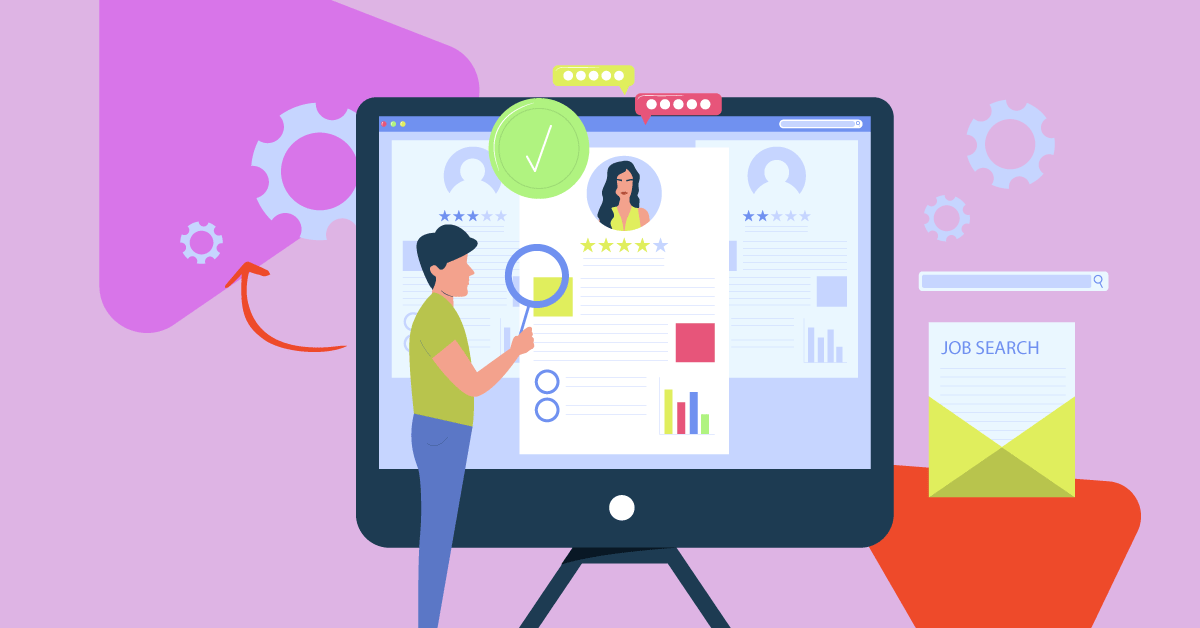
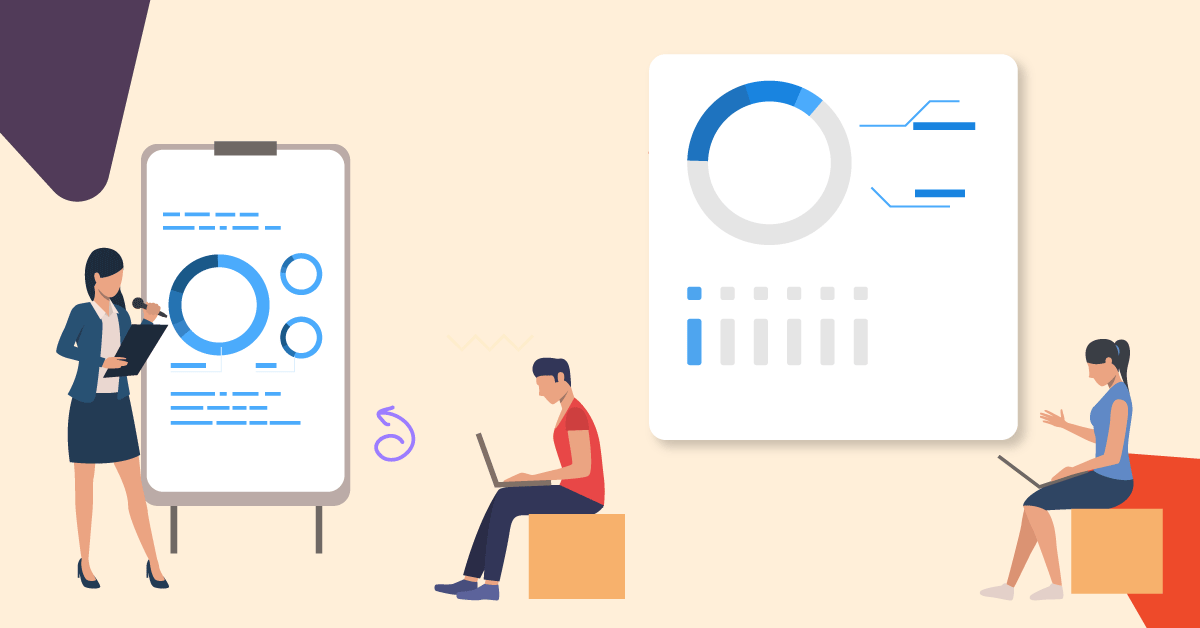
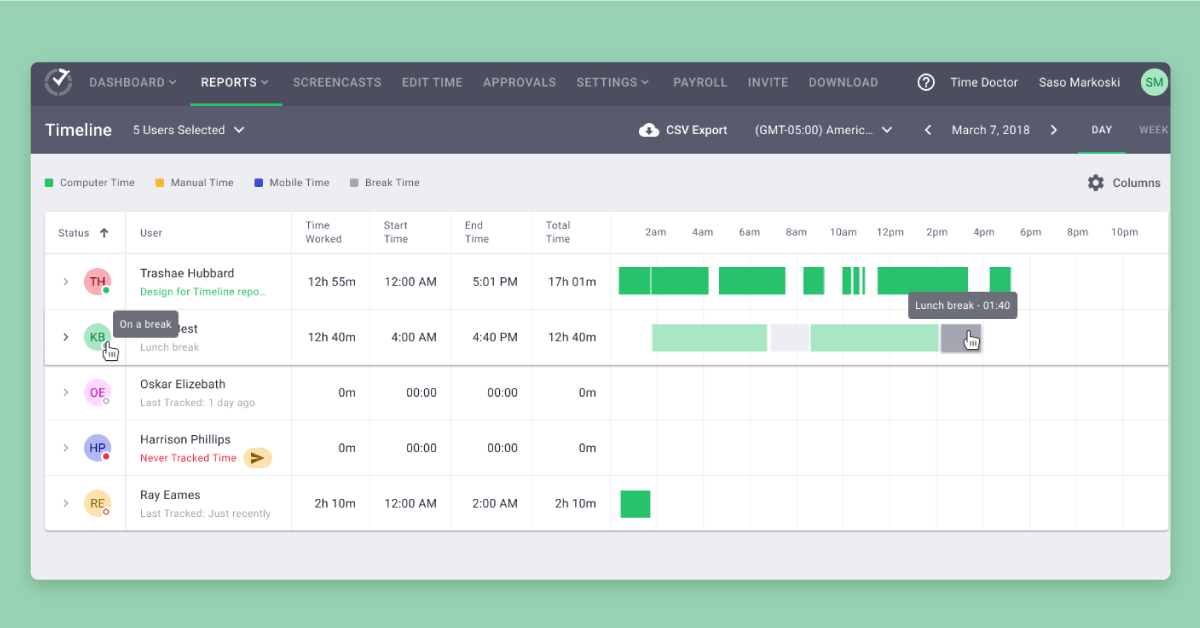 Time Doctor was founded in 2012 by Rob Rawson and Liam Martin and is a remote employee software. Both of them developed Time Doctor’s features around the belief that the future of work is remote, enabling their customers to set up distributed teams. A few such customers include SEOZEO, Ericsson, and Verizon.
Time doctor
lets employers track virtual logins and logouts, client billable hours, and the sites their remote staff visit during work hours.What makes Time Doctor unique?Core
Time Doctor features
are attendance,
project management
and budgeting, payroll, timesheets, website monitoring, and time tracking. But what we really like are the distraction alerts. It detects excess social media time and reminds the user to get back on track through pop-ups. This way, you’re getting a breather but are also reminded of when it's time to refocus, which is great!Key Features:
Time Doctor was founded in 2012 by Rob Rawson and Liam Martin and is a remote employee software. Both of them developed Time Doctor’s features around the belief that the future of work is remote, enabling their customers to set up distributed teams. A few such customers include SEOZEO, Ericsson, and Verizon.
Time doctor
lets employers track virtual logins and logouts, client billable hours, and the sites their remote staff visit during work hours.What makes Time Doctor unique?Core
Time Doctor features
are attendance,
project management
and budgeting, payroll, timesheets, website monitoring, and time tracking. But what we really like are the distraction alerts. It detects excess social media time and reminds the user to get back on track through pop-ups. This way, you’re getting a breather but are also reminded of when it's time to refocus, which is great!Key Features: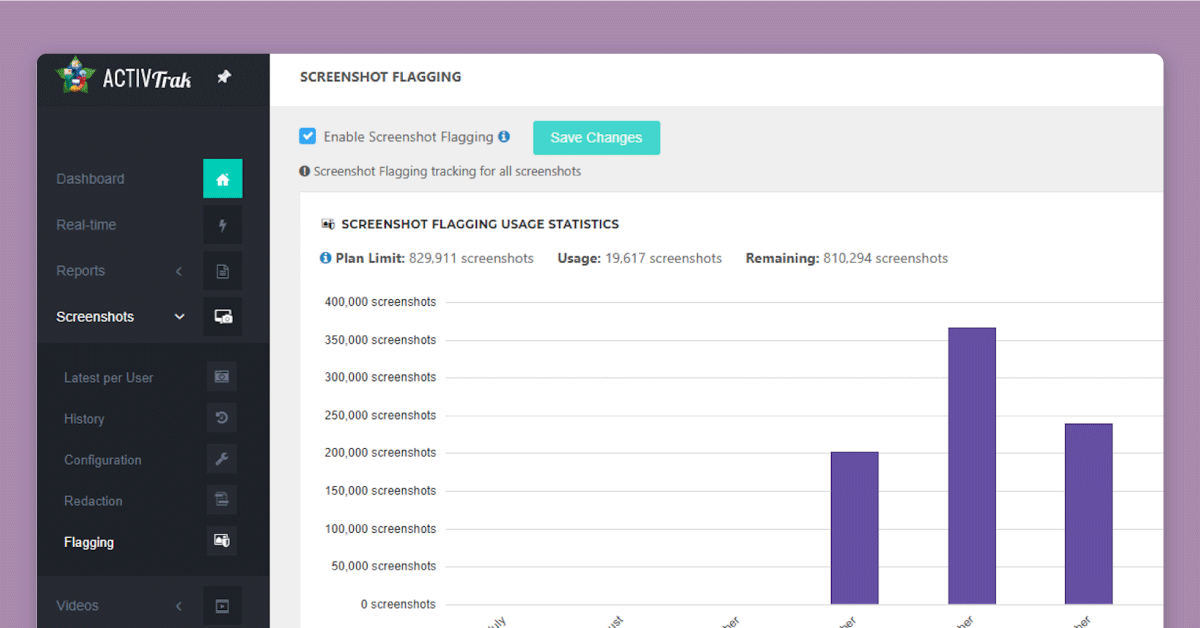 ActivTrak has been in the market for eight years and was founded in Texas by Birch Grove Software. It is a user activity tracking application that picks up the most productive workflows to analyze employee engagement.
ActivTrak
is a productivity-tracking cloud-based app. It gives businesses visibility into user activity and lets employers configure and enforce remote work monitoring software policies.:What Makes ActivTrak Unique?We liked that ActivTrak has use cases for insider threat detection features, data compliance and privacy, which aren’t commonplace in many
remote employee monitoring
tools. Also, the key insights are accessible on one dashboard and are bite-sized, making them easier to understand.Key Features:
ActivTrak has been in the market for eight years and was founded in Texas by Birch Grove Software. It is a user activity tracking application that picks up the most productive workflows to analyze employee engagement.
ActivTrak
is a productivity-tracking cloud-based app. It gives businesses visibility into user activity and lets employers configure and enforce remote work monitoring software policies.:What Makes ActivTrak Unique?We liked that ActivTrak has use cases for insider threat detection features, data compliance and privacy, which aren’t commonplace in many
remote employee monitoring
tools. Also, the key insights are accessible on one dashboard and are bite-sized, making them easier to understand.Key Features: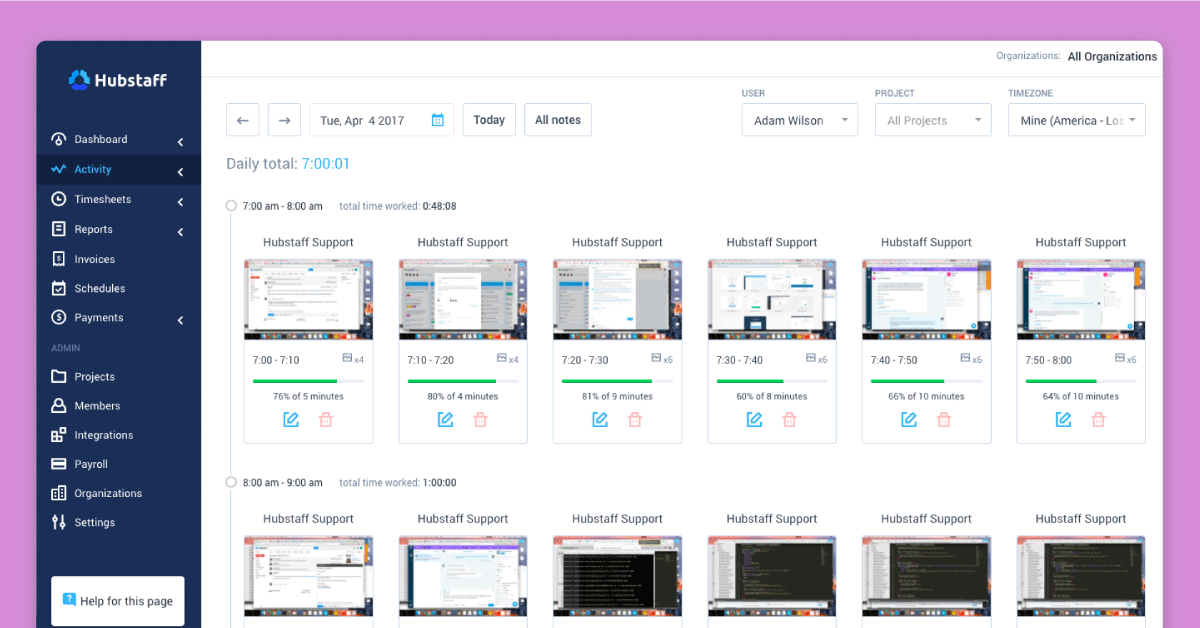 Hubstaff is an
employee time tracking software
that was launched in 2012. Like Time Doctor, Hubstaff is powered by a 100% remote team. Other platforms in addition to time tracking, include
agile project management
and talent management for job finding and remote hiring..Hubstaff brings up shifts, time off requests, and team availability so that employers can plan and assign to-dos to remote teams.What Makes Hubstaff Unique?The first thing we noticed about Hubstaff was how user-experience oriented its remote employee monitoring tools are. Our personal favorite was the
geofencing
feature that automatically starts and stops time tracking according to when members log in and log out. We also liked the option to add budget limits to new projects. It alerts you of clock-bound activities and lets you know how and where time is being spent.Key Features:
Hubstaff is an
employee time tracking software
that was launched in 2012. Like Time Doctor, Hubstaff is powered by a 100% remote team. Other platforms in addition to time tracking, include
agile project management
and talent management for job finding and remote hiring..Hubstaff brings up shifts, time off requests, and team availability so that employers can plan and assign to-dos to remote teams.What Makes Hubstaff Unique?The first thing we noticed about Hubstaff was how user-experience oriented its remote employee monitoring tools are. Our personal favorite was the
geofencing
feature that automatically starts and stops time tracking according to when members log in and log out. We also liked the option to add budget limits to new projects. It alerts you of clock-bound activities and lets you know how and where time is being spent.Key Features: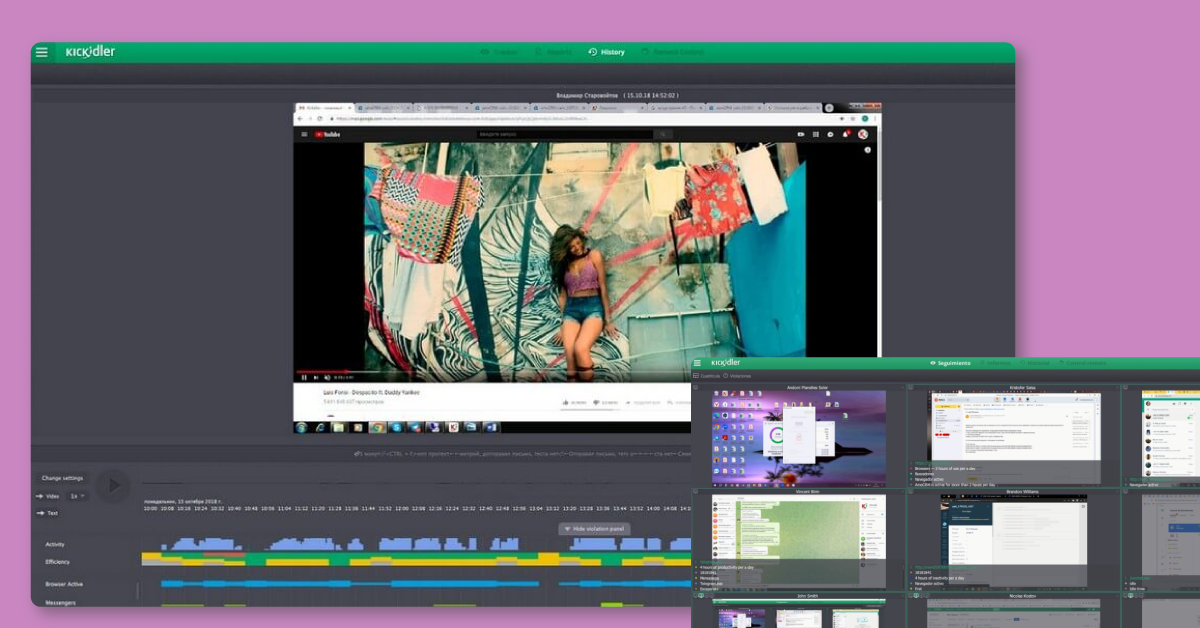 Kickidler has been one of the top employee monitoring software for almost a decade. This software helps to improve the productivity of employees, raise their discipline and impact the increase of business outcomes by around 15%. Business owners, CEOs, department heads or any decision maker can receive the user activity results for any period of time and make relevant decisions. Live monitoring is very easy to use and can be turned off at any time.What makes Kickidler unique?Its most unique feature is the real-time monitoring which records every second and can be downloaded at any time. Kickidler also offers detailed reports on employee productivity based on the time used to work with websites and apps. Other user activity monitoring features include violation reports, URL reports, working time reports, and employee ratings. The latter is effective in boosting employee competition.Key Features:
Kickidler has been one of the top employee monitoring software for almost a decade. This software helps to improve the productivity of employees, raise their discipline and impact the increase of business outcomes by around 15%. Business owners, CEOs, department heads or any decision maker can receive the user activity results for any period of time and make relevant decisions. Live monitoring is very easy to use and can be turned off at any time.What makes Kickidler unique?Its most unique feature is the real-time monitoring which records every second and can be downloaded at any time. Kickidler also offers detailed reports on employee productivity based on the time used to work with websites and apps. Other user activity monitoring features include violation reports, URL reports, working time reports, and employee ratings. The latter is effective in boosting employee competition.Key Features: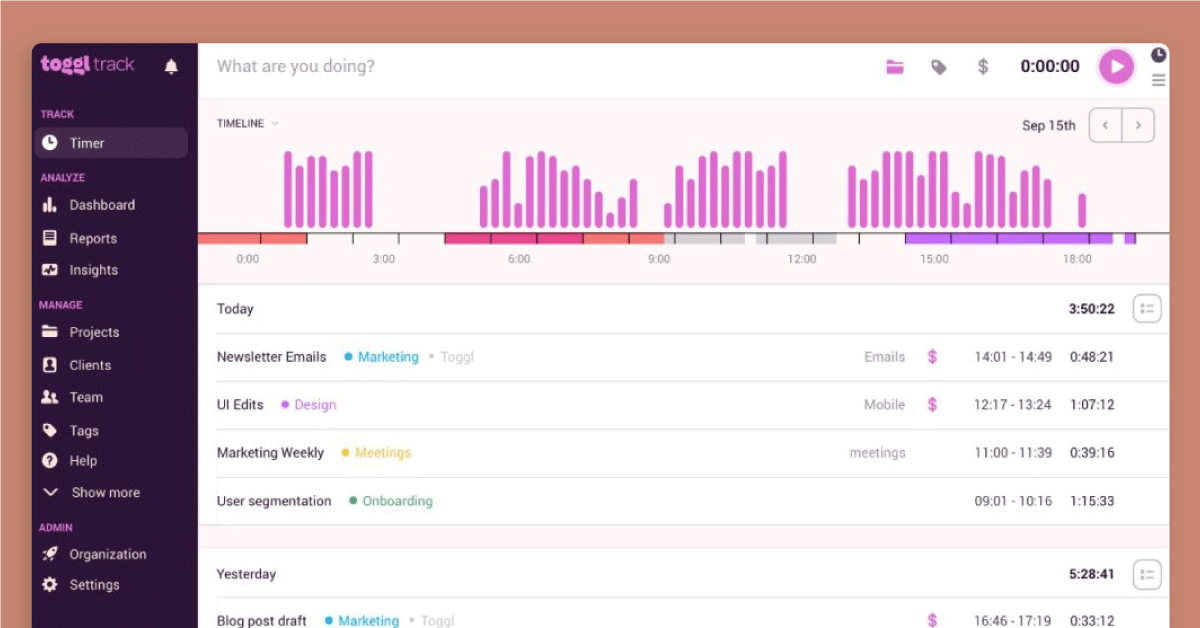 Toggl is an Estonian-based time tracking app that has been in business since 2006. Like Hubstaff and TimeDoctor, Toggl transitioned to a
fully remote team
in 2014 and has registered over 1 million users since 2016. Toggl helps managers keep remote teams productive with its inbuilt idle-time detection and time-tracking facility. It breaks down hours by projects, tasks, and clients to help you ascertain which projects make you money, and which are holding teams back.What Makes Toggl Unique?We liked the Toggl button that sends out tracking reminders. It also has time-sensitive idle detection that activates if you forget to stop the timer manually making it a great employee productivity monitoring software. You can then return and review time reports. We also like team members in a remote network who can assign billable rates to their work to ensure they’re paid fairly for the time they spend on tasks.Key Features:
Toggl is an Estonian-based time tracking app that has been in business since 2006. Like Hubstaff and TimeDoctor, Toggl transitioned to a
fully remote team
in 2014 and has registered over 1 million users since 2016. Toggl helps managers keep remote teams productive with its inbuilt idle-time detection and time-tracking facility. It breaks down hours by projects, tasks, and clients to help you ascertain which projects make you money, and which are holding teams back.What Makes Toggl Unique?We liked the Toggl button that sends out tracking reminders. It also has time-sensitive idle detection that activates if you forget to stop the timer manually making it a great employee productivity monitoring software. You can then return and review time reports. We also like team members in a remote network who can assign billable rates to their work to ensure they’re paid fairly for the time they spend on tasks.Key Features: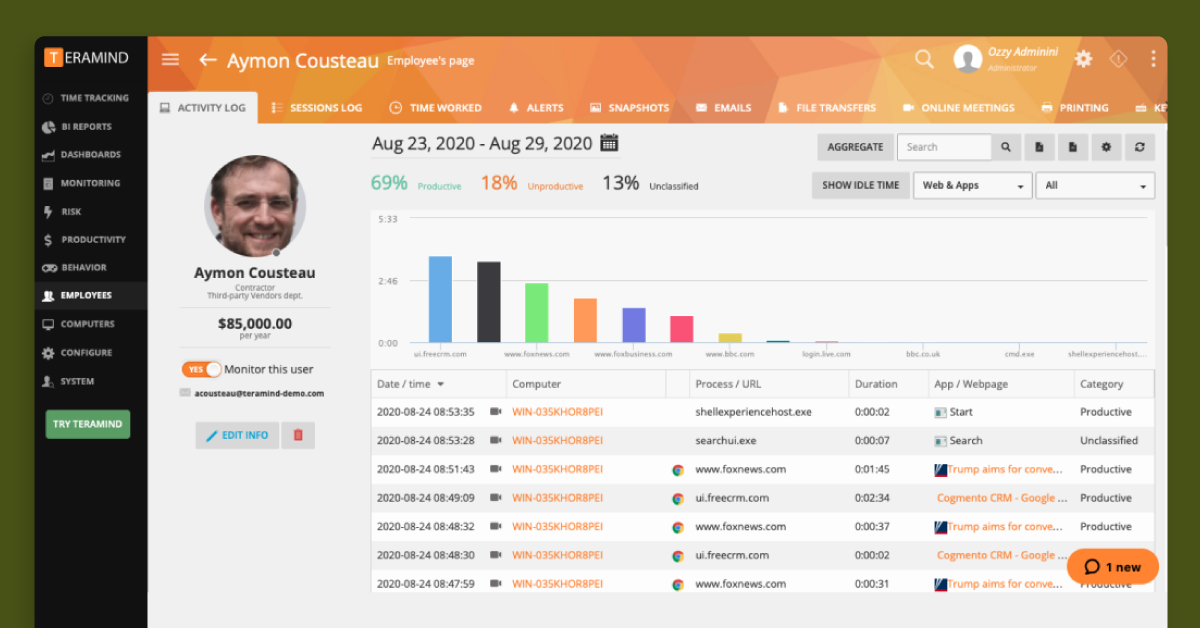 Launched in 2014,Teramind is based in the US and is a robust user behavior analytics tracking platform. It keeps track of expense and time entries. Teramind features Data Loss Protection(DLP) and User Activity Monitoring(UAM).However, the reports caught our attention with comparative metrics like active vs. idle time and productive and unproductive time.What Makes Teramind Unique?We particularly liked Teramind policy and rules engine, which focuses on protecting businesses from data theft.
Teramind
is intended for businesses that want to monitor user actions when online. It maintains access logs across all devices to help track and control activity.Key Features:
Launched in 2014,Teramind is based in the US and is a robust user behavior analytics tracking platform. It keeps track of expense and time entries. Teramind features Data Loss Protection(DLP) and User Activity Monitoring(UAM).However, the reports caught our attention with comparative metrics like active vs. idle time and productive and unproductive time.What Makes Teramind Unique?We particularly liked Teramind policy and rules engine, which focuses on protecting businesses from data theft.
Teramind
is intended for businesses that want to monitor user actions when online. It maintains access logs across all devices to help track and control activity.Key Features: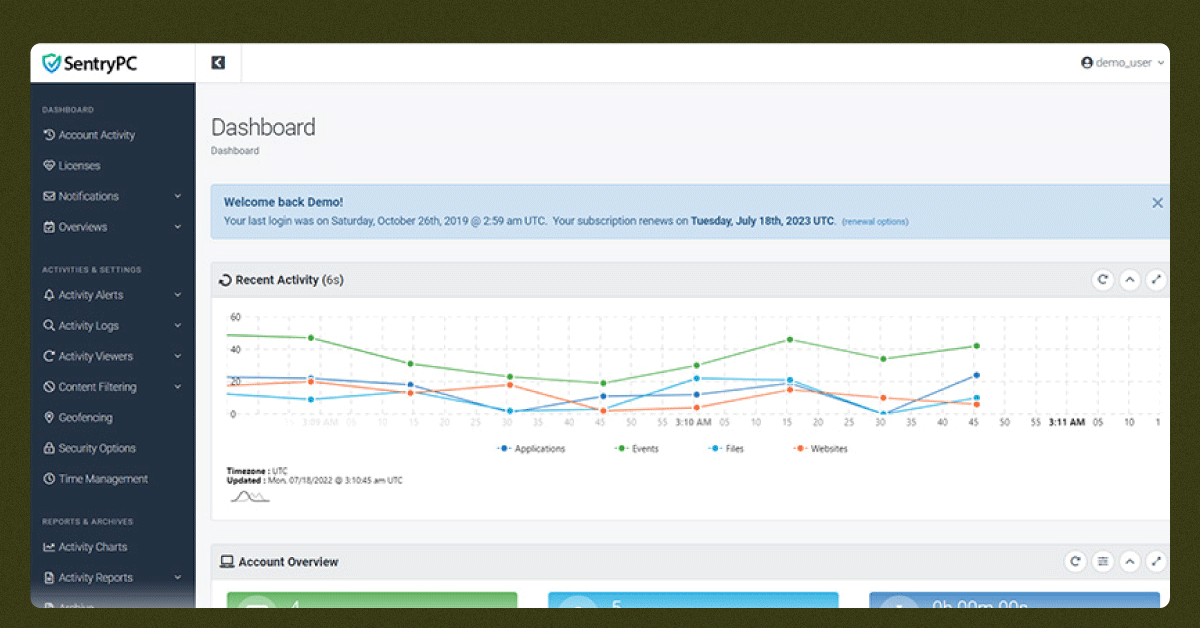 SentryPC
started as Access Control Software in 2001, which makes it one of the oldest monitoring tools in the space. The product offerings are for businesses, families, and schools.SentryPC monitors, filters, and controls user activities remotely. It lets managers specify hours for which attempts to access non-work-related sites should be blocked, thereby preventing virtual distractions.What Makes SentryPC Unique?We like the real-time viewing and time management capabilities within SentryPC. It lets you view keystrokes, conversations, and even websites that are frequented. This can seem a tad too invasive, but this is because the product caters to schools and homes and is intended to secure your system against cybercrime targeting the vulnerable.Key Features:
SentryPC
started as Access Control Software in 2001, which makes it one of the oldest monitoring tools in the space. The product offerings are for businesses, families, and schools.SentryPC monitors, filters, and controls user activities remotely. It lets managers specify hours for which attempts to access non-work-related sites should be blocked, thereby preventing virtual distractions.What Makes SentryPC Unique?We like the real-time viewing and time management capabilities within SentryPC. It lets you view keystrokes, conversations, and even websites that are frequented. This can seem a tad too invasive, but this is because the product caters to schools and homes and is intended to secure your system against cybercrime targeting the vulnerable.Key Features: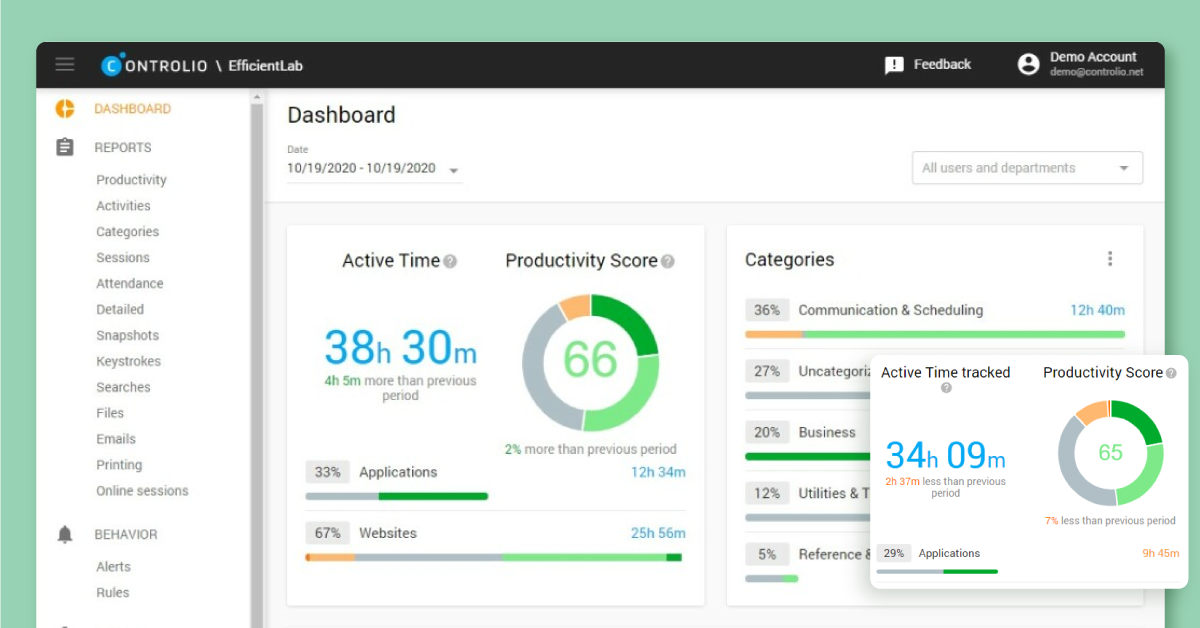 Controlio
is a remote monitoring tool launched in 2017 by EfficientLabs. Unlike Work examiner which is an on-premise solution, Controlio is web-based. It operates in the background under stealth mode and is free for up to 3 computers. Signing up for the Controlio dashboard is hassle-free. After you install the client program, you’ll get to monitor screens live, and record user activities. Since it's hosted on the cloud, there’s no limit to screenshots and time-stamped video recordings that can be uploaded.What Makes Controlio Unique?We liked the fact that the tool is intuitive and easy to use. We aren’t big proponents of blocking certain websites for employees to use but if you are a company that deals with sensitive information, this is the tool for you. This platform also helps avoid micromanaging since the reports allow you to see all the statistics that truly matter. If you are looking for a work from home monitoring software, this is the perfect fit.Key Features:
Controlio
is a remote monitoring tool launched in 2017 by EfficientLabs. Unlike Work examiner which is an on-premise solution, Controlio is web-based. It operates in the background under stealth mode and is free for up to 3 computers. Signing up for the Controlio dashboard is hassle-free. After you install the client program, you’ll get to monitor screens live, and record user activities. Since it's hosted on the cloud, there’s no limit to screenshots and time-stamped video recordings that can be uploaded.What Makes Controlio Unique?We liked the fact that the tool is intuitive and easy to use. We aren’t big proponents of blocking certain websites for employees to use but if you are a company that deals with sensitive information, this is the tool for you. This platform also helps avoid micromanaging since the reports allow you to see all the statistics that truly matter. If you are looking for a work from home monitoring software, this is the perfect fit.Key Features: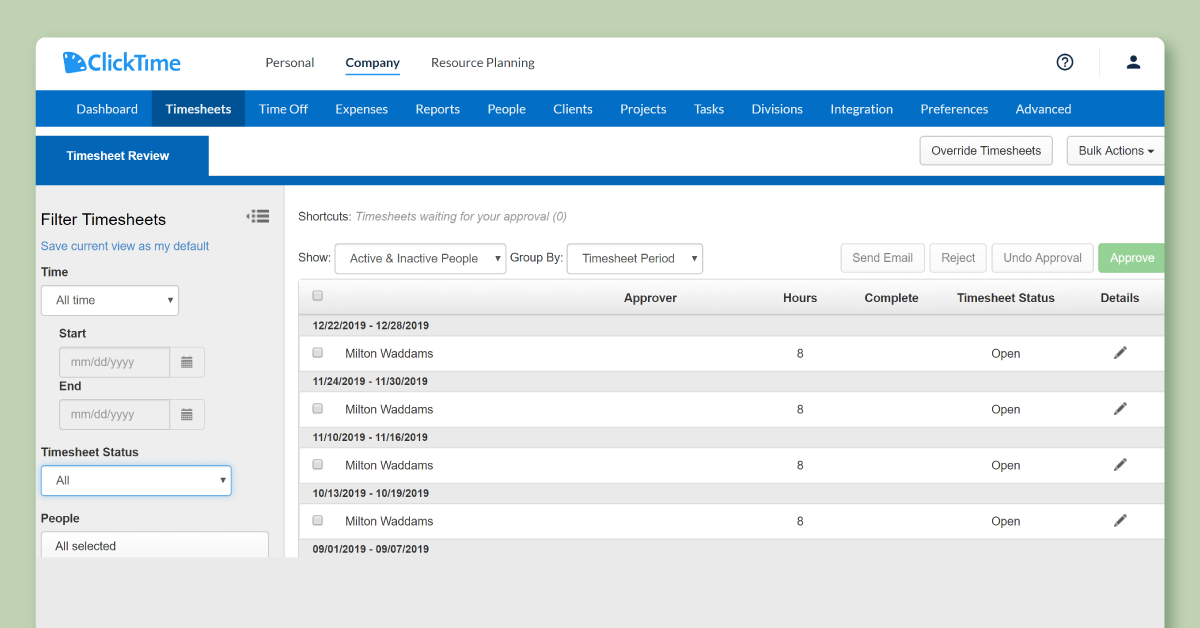 ClickTime
is the oldest find in this post, going back all the way to 1997. A division of Mann consulting, Clicktime was initially a web-based timesheet that gradually expanded its capabilities to include reporting, expense and time-tracking, and employee hour and performance tracking.What Makes ClickTime Unique?Three things we liked about ClickTime are their multi-device time-tracking, workforce planning and in-depth productivity report filtering based on employee, team or project. Also, there are templates for you to start on, such as resource planning,project cost estimation and capacity utilization, which we have not come across in the other remote employee tracking software discussed so far.Key Features:
ClickTime
is the oldest find in this post, going back all the way to 1997. A division of Mann consulting, Clicktime was initially a web-based timesheet that gradually expanded its capabilities to include reporting, expense and time-tracking, and employee hour and performance tracking.What Makes ClickTime Unique?Three things we liked about ClickTime are their multi-device time-tracking, workforce planning and in-depth productivity report filtering based on employee, team or project. Also, there are templates for you to start on, such as resource planning,project cost estimation and capacity utilization, which we have not come across in the other remote employee tracking software discussed so far.Key Features: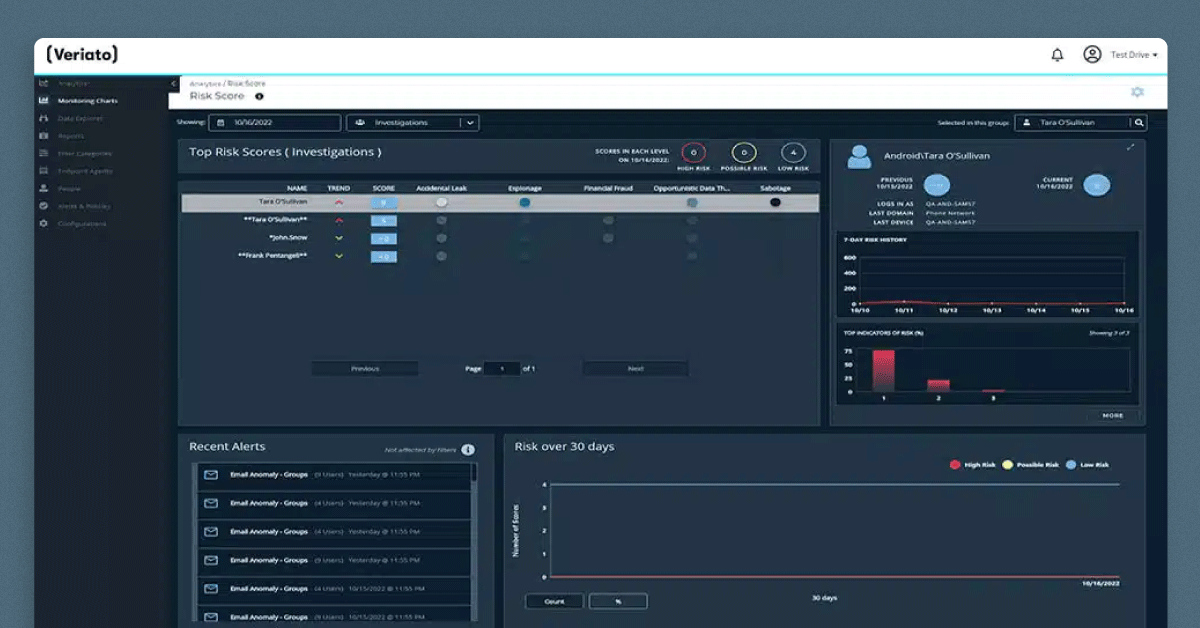 Veriato started out in 1998 and was one of the earliest-known entrants into internet monitoring. The different products are cerebral, investigator,vision, and ransom safe
Veriato’s
work-from-home friendly platform lets
remote managers
create daily activity logs and weekly vision reports (like a vision board). It gives visibility into what a remote resource is working on at any given time. Veriato is robust and protects your data from threatsWhat Makes Veriato Unique?We liked the
Vision platform,
in particular. It monitors employee productivity and records online activities,keystrokes typed, messages,online searches, website footfall,social media sites, and even the usage of USB sticks. This software works great irrespective of what your set up is, hybrid or remote.Key Features:
Veriato started out in 1998 and was one of the earliest-known entrants into internet monitoring. The different products are cerebral, investigator,vision, and ransom safe
Veriato’s
work-from-home friendly platform lets
remote managers
create daily activity logs and weekly vision reports (like a vision board). It gives visibility into what a remote resource is working on at any given time. Veriato is robust and protects your data from threatsWhat Makes Veriato Unique?We liked the
Vision platform,
in particular. It monitors employee productivity and records online activities,keystrokes typed, messages,online searches, website footfall,social media sites, and even the usage of USB sticks. This software works great irrespective of what your set up is, hybrid or remote.Key Features: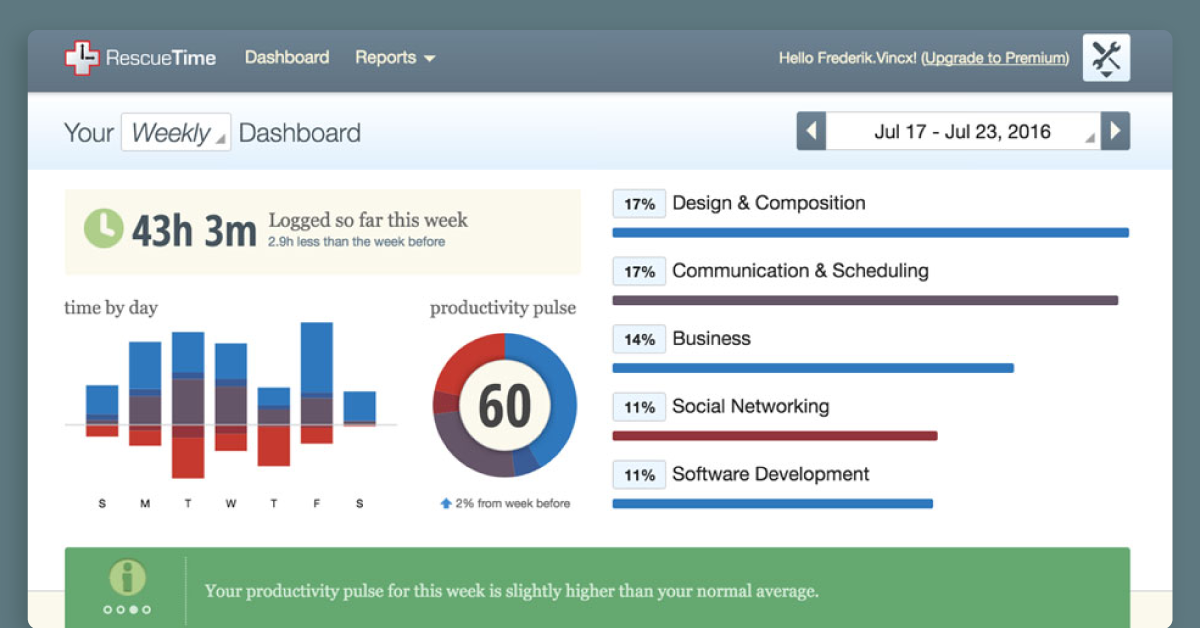 Developed in 2008,
Rescuetime
has been in business as a remote work tracking software for 12 years and automates time tracking.
Rescuetime
is a time management platform for remote teams that lets them stay focused on their priorities while on the clock.What Makes RescueTime Unique?We have mentioned RescueTime in a
previous read
but felt that it deserves to go into this compilation as well. We like how you can get a 360 degree picture on work meetings, calls, projects, and everything else to know where you need to scale back or hit the pause button on busywork.Key Features:
Developed in 2008,
Rescuetime
has been in business as a remote work tracking software for 12 years and automates time tracking.
Rescuetime
is a time management platform for remote teams that lets them stay focused on their priorities while on the clock.What Makes RescueTime Unique?We have mentioned RescueTime in a
previous read
but felt that it deserves to go into this compilation as well. We like how you can get a 360 degree picture on work meetings, calls, projects, and everything else to know where you need to scale back or hit the pause button on busywork.Key Features: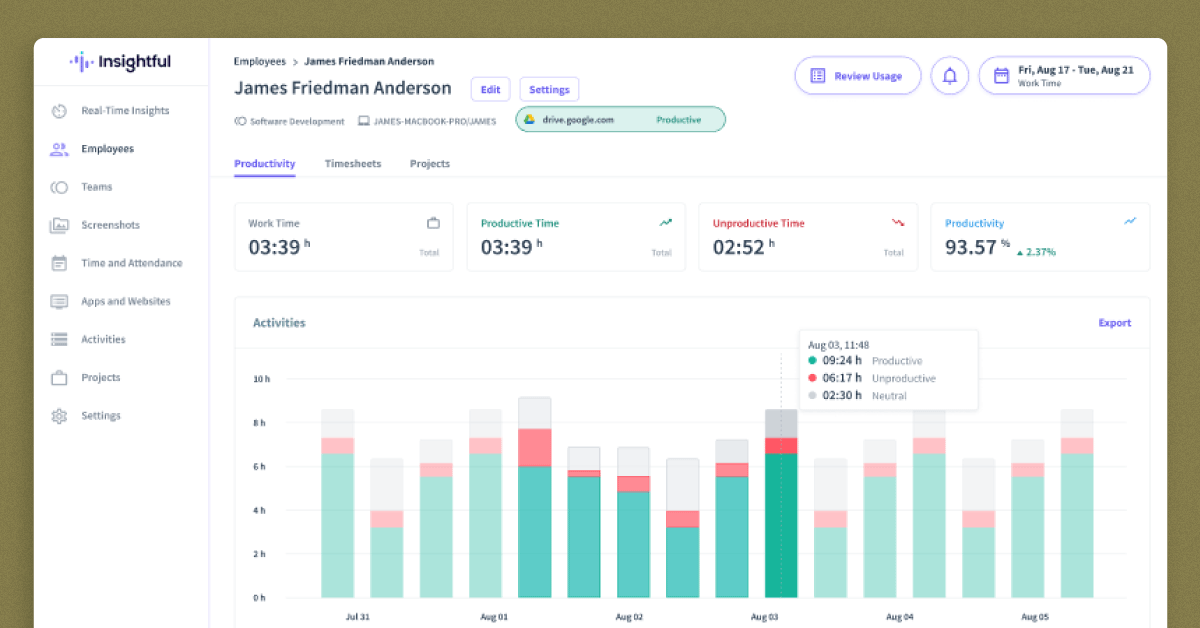 Insightful was founded in 2015 by Serbian entrepreneur Ivan Petrovic. It has been reported to have helped businesses save $10 million in time annually and boost clock-in time by 15%. Insightful is a productivity monitoring tool that analyzes web interactions, and labels work as productive or not for employers.What Makes Workpuls Unique?We like that Insightful lets you categorize websites by their relevance to your work. This way, you know where to spend your time on. Also, it records attendance by breaking up the day into logins, break-times, and work hours.Key Features:
Insightful was founded in 2015 by Serbian entrepreneur Ivan Petrovic. It has been reported to have helped businesses save $10 million in time annually and boost clock-in time by 15%. Insightful is a productivity monitoring tool that analyzes web interactions, and labels work as productive or not for employers.What Makes Workpuls Unique?We like that Insightful lets you categorize websites by their relevance to your work. This way, you know where to spend your time on. Also, it records attendance by breaking up the day into logins, break-times, and work hours.Key Features: Interested in Virtual Team Building Events?
Interested in Virtual Team Building Events?



